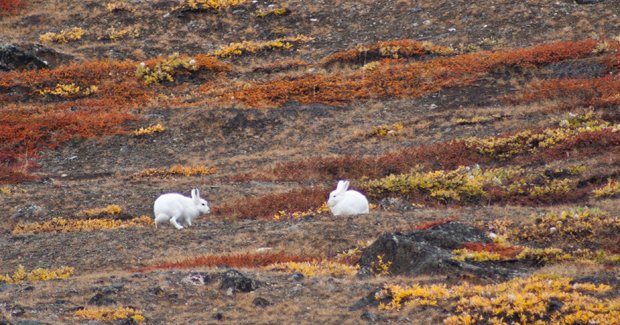Arctic jewels: icebergs and musk ox

Regular Australian Geographic contributor Ken Eastwood spent 14 days sailing around Iceland, Greenland and Spitsbergen on an AG Society expedition in September 2011. Read the full story in issue 106 of Australian Geographic and find more details about going on the 2012 expedition below.
WOW. OUR FIRST FULL DAY in Greenland and it’s going to be pretty hard to top this. We awake in a spectacular, steep-sided fjord called Nordfjord, in East Greenland, the vessel moored beside some stunning blue-and-white icebergs, including one that looks like a giant duck.
Musk ox graze on the hillsides and dazzling white Arctic hares feed and hop around creek lines, looking conspicuous against the autumnal mosaic of tundra. In one of the many great adaptations of animals in this area, the hares are nearly all white in winter, but generally brown in summer. Thankfully these ones are already white, making them easier to spot.
As much as possible, on the expedition we get the chance to go out on inflatable boats called zodiacs, exploring the landscape. So, after a hearty breakfast we are out for our first landing, via an array of nearby icebergs. As big as service stations, the bergs come in a fantastic array of shapes, including geometrical designs with sharp angles, and castles with towering turrets.


Icebergs ahoy!
Icebergs calve straight off glaciers and, according to our onboard naturalist Dmitri Banin, about 90 per cent of the icebergs in the Arctic originate in Greenland.
Once on land, we delve into the plant patchwork while small Arctic birds called snow buntings and wheatears flit in and out of the lichen-speckled rocks. In among the palette of vegetation (that includes bright reds and oranges of birch, and the yellow of willows) are hidden gems – occasional edible blue berries, harebells called tikiusaaq and the floral emblem of Greenland, the pine niviarsiaq, which is delicate and pink.
Plants here rarely grow more than a few centimetres above the ground, not just because of the high winds and freezing air that regularly hits -30ºC in winter, but because the ground is permanently frozen from about 10-15cm down. Yet, some 500 species of vascular plant eke out an existence, so there is plenty of diversity.
Through this visual feast we saunter up the hill toward some of the grazing musk ox. More related to sheep than cows or oxen, musk ox aren’t as big as they appear in most pictures. They stand about 1.5m tall, and weigh on average about 315kg. Both the females and males have horns, and they aren’t afraid to use them – either to sort out differences between themselves, or for protection.
“They don’t have very good eyesight – it’s much worse than human eyesight,” Dmitri says. “When they sense danger, they make a wall of horns and charge anything that challenges them.”
Musk ox usually graze in separate groups of males and females, but as we carefully creep up on a group from the leeward side, we discovered this was a mixed group that even included one young musk ox still drinking from the teat.

Musk ox at Kong Oscar Fjord in north-eastern Greenland. (Credit: Hannes Grobe/AWI).
Eskimo Bay
Then it was back to our ship, the Polar Pioneer, to cruise through a sound with glaciers winding down off the icecap, and many other musk ox watching us from on high. The sun glints on jagged 2000m high peaks, dispersing the cloud.
At Eskimo Bay, where the charts suggest the water is 1000m deep, everybody is on deck hearing icebergs crack and calve, sounding like explosions and sending blue ripples through the water. Before long we are back on land, watching a musk ox powering up a vertical hill and gazing in awe at the vast vista.
That is meant to be the end of our outings for the day, but after dinner the plans change – as they do on every expedition of this kind – and we are back out in the zodiacs at 8.30pm (the sunset is around 9pm, but it stays light until 11), among the brash ice, while the long evening paints faint yellows, golds and oranges through the sky.
Beneath a towering peak with three prongs reaching to the heavens, we explore the realm of a vast natural blue-and-white iceberg palace as big as three or four city blocks. It has statues and altars hidden in caves, regal blue halls and arches galore. Pillars, formed by tidal and water erosion, look like intricately carved ivory.
As we watch, we see bits falling off this unstable structure, sometimes with cracks that sound like rifle shots and other times with a rumble like thunder. When one giant shelf gives way, our zodiacs race away from the wave as it speeds towards us.
What an iceberg. What a day.
Learn more about how to sign up to the 2012 expedition and find detailed information about the itinerary here.
RELATED STORIES

